2011–12 Strait of Hormuz dispute
The Strait of Hormuz dispute is an ongoing dispute between a coalition of countries and Iran. The dispute arose on 27 December 2011, when Iranian Vice President Mohammad-Reza Rahimi threatened to close the Strait of Hormuz.[9] In late April 2019 Iran said that it will block any shipping if it was barred from using the strategic waterway and in face of US sanctions[10]
| 2011–12 Strait of Hormuz dispute | |||||||
|---|---|---|---|---|---|---|---|
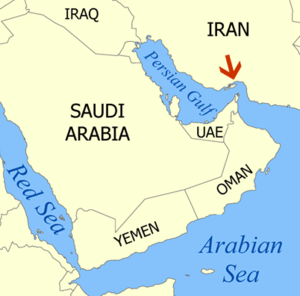 Strait of Hormuz highlighted by a red arrow on the image | |||||||
| |||||||
| Belligerents | |||||||
|
|
| ||||||
| Units involved | |||||||
|
United States Navy[1] Royal Navy[1] French Navy[1] Royal Australian Navy[2] | Islamic Republic of Iran Navy | ||||||
| Strength | |||||||
|
2012 2019 |
2012 2019 Unknown | ||||||
| Casualties and losses | |||||||
|
2012 2019 1 drone shot down[7][8] |
2012 2019 | ||||||
Subsequently, a number of naval drills and missile tests were carried out by Iran. A coalition of countries responded by sending a flotilla of warships to deter any Iranian attempt to close the Strait of Hormuz and warned Iran publicly and through letters not to close the Strait.
The dispute was interjected by a European Union sanction banning oil exports from Iran to Europe on 23 January 2012 in an attempt to deter Iran from continuing with their nuclear program. Oil exports contribute to about 80% of Iranian public revenue,[11] with roughly 20% being exported to Europe. Asian countries such as Japan and South Korea, which both account for 26% of Iran's oil exports have expressed a willingness to reduce oil exports from Iran.[12]
Background
The Strait is situated off the coast of Iran and is a recognised international trade route. The strait is narrowest at 21 nautical miles (39 km) and is recognised as a naval choke point.[13] Oil is a key commodity with approximately 20% of seaborne oil in the world transported via the Strait of Hormuz.[14]
The Strait of Hormuz has been the scene of a stand-off between Iran and the United States before. On 18 April 1988, the U.S. Navy waged a one-day battle against Iranian forces in and around the strait. The battle, dubbed Operation Praying Mantis by the U.S. side, was launched in retaliation for the mining of USS Samuel B. Roberts on 14 April by Iran. U.S. forces sank one Islamic Republic of Iran Navy frigate, one gunboat, and as many as six armed speedboats in the engagement and seriously damaged a second frigate.
On 26 January 2012, The Christian Science Monitor wrote:
Iran's strategy of asymmetric warfare recognizes that, since the 1979 Islamic Revolution, Iran has little chance of winning any face-to-face military contest with powerful enemies like the United States.
Instead, Iran aims to "exploit enemy vulnerabilities through the used of 'swarming' tactics by well-armed small boats and fast-attack craft, to mount surprise attacks at unexpected times and places" which will "ultimately destroy technologically superior enemy forces," writes Iranian military expert Fariborz Haghshenass in a 2008 study based on published doctrines of the Islamic Revolutionary Guard Corps (IRGC).[15]
— [16]' Peterson
Teheran can accomplish its objectives simply by clogging the strait, adds the Monitor. The Monitor also makes reference to Millennium Challenge 2002, a major war game exercise conducted by the United States armed forces in mid-2002, in which Red forces, commanded by retired Marine Corps Lt. General Paul K. Van Riper, used old methods to evade Blue's sophisticated electronic surveillance network, and a significant portion of Blue's navy was "sunk".
Dispute
On 27 December 2011, Iranian Vice President Mohammad-Reza Rahimi threatened to cut off oil supply from the Strait of Hormuz should economic sanctions limit, or cut off, Iranian oil exports.[17] Also on that same date, the U.S. aircraft carrier USS John C. Stennis (CVN-74) concluded a four-day port visit to Jebel Ali, United Arab Emirates, and returned to the North Arabian Sea in support of coalition ground operations in Afghanistan via the Strait of Hormuz.[18][19]
To coincide with this threat, Iran carried out Velayat 90, a 10-day military exercise in international waters near the Strait of Hormuz.[20] The United States countered this exercise with an increased naval presence in and around the Persian Gulf, with the aircraft carrier John C. Stennis pictured by Iranian reconnaissance in the Persian Gulf.[20] A U.S. Fifth Fleet spokeswoman said in response that the Fleet was "always ready to counter malevolent actions", whilst Admiral Habibollah Sayari of the Iranian navy claimed that cutting off oil shipments would be "easy".[21] Security analysts in the West were largely unconcerned by Iran's capabilities to disrupt trade in the area.[22]
On 3 January 2012, following the end of Velayat 90, the Iranian Army chief of staff, General Ataollah Salehi, was quoted by the state news agency IRNA as warning the United States to not deploy the Stennis back to the Persian Gulf.[19] Iranian Army chief Ataollah Salehi said the United States had moved an aircraft carrier out of the Gulf because of Iran's naval exercises, and Iran would take action if the ship returned. "Iran will not repeat its warning...the enemy's carrier has been moved to the Gulf of Oman because of our drill. I recommend and emphasize to the American carrier not to return to the Persian Gulf", he said.[23][24]
On 4 January 2012, Fars News Agency reported that a bill was being prepared for the Iranian Parliament to bar foreign naval vessels from entering the Persian Gulf unless they receive permission from the Iranian navy, with Iranian lawmaker Nader Qazipour noting: "If the military vessels and warships of any country want to pass via the Strait of Hormuz without coordination and permission of Iran’s navy forces, they should be stopped by the Iranian armed forces."[25] Also, Iranian Defense Minister Ahmad Vahidi reiterated that "transnational forces" have no place in the Persian Gulf region.[25]
The U.S. Navy spokesman Commander Bill Speaks quickly responded that deployment of U.S. military assets would continue as has been the custom stating: "The U.S. Navy operates under international maritime conventions to maintain a constant state of high vigilance in order to ensure the continued, safe flow of maritime traffic in waterways critical to global commerce."[26]
_and_USS_John_C._Stennis_(CVN_74)_join_for_a_turnover_of_responsibility_in_the_Arabian_Sea.jpg)
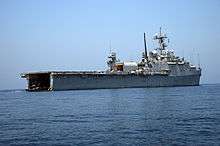
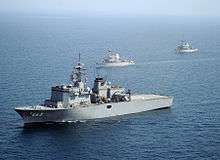

On 7 January 2012, the United Kingdom announced that it would be sending the Type 45 destroyer HMS Daring to the Persian Gulf. Daring, which is the lead ship of her class is claimed to be one of the "most advanced warships" in the world, and will undertake its first mission in the Persian Gulf.[27] The British Government however have said that this move has been long-planned, as Daring will replace another Armilla patrol frigate.[28] During this maiden deployment, Daring operated with Carrier Strike Group One in the Persian Gulf and Carrier Strike Group Nine in the North Arabian Sea.[29][30]
On 9 January 2012, Iranian Defense Minister Ahmad Vahidi denied that Iran had ever claimed that it would close the Strait of Hormuz, saying that "the Islamic Republic of Iran is the most important provider of security in the strait...if one threatens the security of the Persian Gulf, then all are threatened."[31] However, Vahidi did reiterate that "transnational forces" have no place in the Persian Gulf region.[25] Also, on 9 January 2012, Carrier Strike Group One, led by the carrier Carl Vinson, joined Carrier Strike Group Three, led by the Stennis, in the North Arabian Sea. Carrier Strike Group Nine, led by the carrier Abraham Lincoln, was en route to the Arabian Sea amid rising tensions over the Strait of Hormuz.[32]
The Iranian Foreign Ministry confirmed on 16 January 2012 that it has received a letter from the United States concerning the Strait of Hormuz, "via three different channels." Authorities were considering whether to reply, although the contents of the letter were not divulged.[33] The US had previously announced its intention to warn Iran that closing the Strait of Hormuz is a "red line" that would provoke an American response.[34] Gen. Martin E. Dempsey, the chairman of the Joint Chiefs of Staff, said this past weekend that the United States would "take action and reopen the strait," which could be accomplished only by military means, including minesweepers, warship escorts and potentially airstrikes. Defense Secretary Leon E. Panetta told troops in Texas on Thursday that the United States would not tolerate Iran's closing of the strait. Nevertheless, Iran continued to discuss the impact of shutting the Strait on world oil markets, saying that any disruption of supply would cause a shock to markets that "no country" could manage.[35]
On 19 January 2012, Carrier Strike Group Nine entered the U.S. Fifth Fleet's area of responsibility and relieved Carrier Strike Group Three (pictured).[36] Also on that date, Ambassador of Iran to the United Nations Mohammad Khazaee reportedly stated in a recent interview on the Charlie Rose program that Iran would consider closing the Strait of Hormuz if Iran's security was endangered.[37]
On 22 January 2012, Carrier Strike Group Nine was joined by the British Type 23 frigate Argyll and French frigate La Motte-Picquet and together this American-British-French naval flotilla transited the Strait of Hormuz into the Persian Gulf without incident.[38][39] By 23 January, a flotilla had been established by countries opposing Iran's threats to close the Hormuz Strait.[40] These ships operated in the Persian Gulf and Arabian Sea off the coast of Iran. The flotilla included two American aircraft carriers (the USS Carl Vinson and USS Abraham Lincoln), three destroyers (USS Momsen, USS Sterett, USS Russell) and seven British warships including the destroyer Daring and a number of Type 23 frigates (HMS Westminster, HMS Argyll and HMS Somerset).[41]
On 24 January tensions rose further after the European Union imposed sanctions on Iranian oil. A senior member of Iran's parliament said that the Islamic Republic would close the entry point to the Gulf if new sanctions block its oil exports.[42] "If any disruption happens regarding the sale of Iranian oil, the Strait of Hormuz will definitely be closed," Mohammad Kossari, deputy head of parliament's foreign affairs and national security committee, told the semi-official Fars News Agency.
On 14 February 2012, the carrier Abraham Lincoln, the cruiser Cape St. George, and the destroyer Sterett transited through Strait of Hormuz into the northern Arabian Sea, concluding Carrier Strike Group Nine's initial operations in the Persian Gulf. The strike group's movements were monitored by Iranian patrol boats and aircraft during its transit.[43][44] In addition to combat air support for coalition forces in Afghanistan, Carrier Strike Group Nine maintained flights operations some 30 nautical miles (56 km; 35 mi) off the coast of Iran.[45]
On 6 June 2012, the former amphibious transport dock Ponce (pictured) joined the U.S. Fifth Fleet.[46] The Ponce was converted at a "mother-ship for MH-53E Sea Dragon mine-sweeping helicopters. The U.S. Navy also deployed four more MH-53E helicopter to reinforce the six helicopters based in the Persian Gulf.[47][48][49] On 24 June 2012, four Avenger-class minesweepers joined the U.S. Fifth Fleet for a seven-month deployment.[50] The four ships joined the four other Avenger-class minesweepers based in the Persian Gulf as well as the four British Royal Navy minesweepers operating with the Armilla Patrol.[48] Both U.S. mine-sweeping ships and helicopters were refitted with the new Seafox anti-mine marine drones.[48][49]
In July 2012, Iranian General Hasan Firouzabadi announced Iran's plans to block the Strait of Hormuz if the country's interests are seriously threatened.[51]
The International Mine Countermeasures Exercise 2012, (IMCMEX 12) or IMCMEX 2012, was held 16–27 September 2012 in multiple locations in the U.S. Naval Forces Central Command (NAVCENT) area of operations (pictured). This multi-national mine warfare exercise was the largest ever held in the region, and it involved navies from more than 30 nations. The purpose of IMCMEX 12 was protecting three critical maritime chokepoints at the Strait of Hormuz, the Suez Canal, and the Strait of Bab-el-Mandeb (see map).[52][53]
The Iranian Navy carried out Velayat 91, a six-day exercises held in the Strait of Hormuz that began on 28 December 2012.[54] The exercise commander, Rear Admiral Habibollah Sayyari, noted:
- Among the aims of the drill is to display the capabilities of Iran's Armed Forces and the navy to defend our country's water borders and interests in line with establishing durable security in the region and conveying the message of peace and friendship to the neighboring states.
During Velayat 91, the Iranian Navy test-fired its Noor and Qader cruise missiles, its Ra'd anti-aircraft missiles, and its Nasr tactical ballistic missile.[54]
Consequences
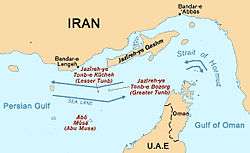
Despite an initial 2% rise in oil prices, oil markets ultimately did not react significantly to the Iranian threat, with oil analyst Thorbjoern Bak Jensen of Global Risk Management concluding that "they cannot stop the flow for a longer period due to the amount of U.S. hardware in the area".[56] While earlier statements from Iran had little effect on global oil markets, coupled with the new sanctions, these terse comments from Iran are driving crude futures higher, up over 4%.[48] Pressure on prices reflect a combination of uncertainty driven further by China's recent response – reducing oil January 2012 purchases from Iran by 50% compared to those made in 2011.[57]
A closure of the Strait of Hormuz would inflate oil prices, not only in the west, but in Asian countries such as Japan, India and South Korea. All three countries collectively account for 42% of Iranian oil exports – Japan 17%, South Korea 9%, and India 16%.[58] China is another importer of Iranian oil, of which it accounts for 20% of Iran's oil exports.[58]
Warships
A number of countries dispatched warships to the Persian Gulf and Arabian Sea in an effort to ward off any Iranian closure of the Hormuz Strait.
- Known warships operating off the coast of Iran – as of 24 January 2012[59]

| Surface warships | Carrier Air Wing Seventeen (CVW-17) squadrons embarked aboard flagship USS Carl Vinson (CVN-70) | ||
|---|---|---|---|
| USS Bunker Hill (CG-52) | Strike Fighter Squadron 113 (VFA-113): 10 F/A-18C | Tactical Electronics Warfare Squadron 134 (VAQ-134): 4 EA-6B | |
| USS Stockdale (DDG-106) | Strike Fighter Squadron 81 (VFA-81): 10 F/A-18E | Carrier Airborne Early Warning Squadron 125 (VAW-125): 4 E-2C | |
| USS Gridley (DDG-101) | Strike Fighter Squadron 25 (VFA-25): 10 F/A-18C | Helicopter Anti-Submarine Squadron 15 (HS-15): 7 HH-60F/SH-60F | |
| USS Higgins (DDG-76) | Strike Fighter Squadron 22 (VFA-22): 12 F/A-18F | Fleet Logistics Support Squadron 40 (VRC-40), Det.4: 2 C-2A | |
| Surface warships | Carrier Air Wing Nine (CVW-9) squadrons embarked aboard flagship USS John C. Stennis (CVN-74) | ||
|---|---|---|---|
| USS Mobile Bay (CG-53) | Strike Fighter Squadron 192 (VFA-192): 10 F/A-18C | Carrier Airborne Early Warning 112 (VAW-112): 4 E-2C | |
| USS Wayne E. Meyer (DDG-108) | Strike Fighter Squadron 97 (VFA-97): 10 F/A-18C | Fleet Logistics Support Squadron 40 (VRC-40), Det. 1: 2 C-2A | |
| USS Dewey (DDG-105) | Strike Fighter Squadron 41 (VFA-41): 12 F/A-18F | Helicopter Sea Combat Squadron Squadron 8 (HSC-8): 7 MH-60S | |
| USS Kidd (DDG-100) | Strike Fighter Squadron 14 (VFA-14): 12 F/A-18E | Helicopter Maritime Strike Squadron 71 (HSM-71): 11 MH-60R | |
| USS Pinckney (DDG-91) | Electronic Attack Squadron 133 (VAQ-133): 4 EA-6B | —— | |
| Surface warships | Carrier Air Wing Two (CVW-2) squadrons embarked aboard flagship USS Abraham Lincoln (CVN-72) | ||
|---|---|---|---|
| USS Cape St. George (CG-71) | Strike Fighter Squadron 151 (VFA-151): 10 F/A-18C | Carrier Airborne Early Warning Squadron (VAW-116): 4 E-2C | |
| USS Sterett (DDG-104) | Strike Fighter Squadron 137 (VFA-137): 12 F/A-18E | Helicopter Sea Combat Squadron 12 (HSC-12): 8 MH-60S | |
| USS Halsey (DDG-97) | Strike Fighter Squadron 34 (VFA-34): 12 F/A-18C(N) | Fleet Logistics Support Squadron 30 (VRC-30), Det. 2: 2 C-2A | |
| USS Momsen (DDG-92) | Strike Fighter Squadron 2 (VFA-2): 12 F/A-18F | Helicopter Strike Maritime Squadron 77 (HSM-77), Det. 7: 8 SH-60B | |
| —— | Tactical Electronics Warfare Squadron 131 (VAQ-131): 5 EA-6B | —— | |
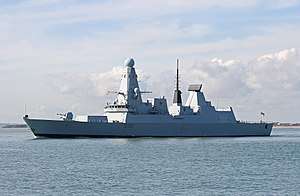
- HMS Argyll
- HMS Somerset
- RFA Lyme Bay
- HMS Ramsey
- HMS Echo
- HMS Daring[68]
- HMS Westminster[69]
- HMS St Albans[70]
- Trafalgar-class submarine[71]
- La Motte-Picquet[72]
See also
- 2007 Iranian seizure of Royal Navy personnel
- 2008 U.S.–Iranian naval dispute
References
- Blair, David (23 January 2012). "Britain, US and France send warships through Strait of Hormuz". The Telegraph. Retrieved 24 January 2012.
- https://www.npr.org/2019/08/22/753334921/australia-joins-u-s-led-maritime-force-protecting-persian-gulf-shipping
- Bomber task force completes first CENTCOM mission as Iran warns US forces to leave region
- US-Iran tensions are escalating at an alarming rate, thanks to well-rehearsed gun diplomacy
- U.S.-IRAN TENSIONS: SIDES SEEK DEESCALATION AS IRAQ SIMMERS - ANALYSIS
- Royal Navy frigate confronts Iranian boats approaching tanker
- Iran's Revolutionary Guard shoots down US drone
- "Iran shoots down US RQ-4 Global Hawk surveillance drone". The Defense Post. 20 June 2019.
- "Iran threatens to block Strait of Hormuz oil route". BBC News. 28 December 2011. Retrieved 25 January 2012.
- FACTBOX-Strait of Hormuz: the world's most important oil artery
- "Iran threatens new war games in the oil lanes of the Gulf". The Telegraph. 6 January 2012. Retrieved 24 January 2012.
- "Q&A: Iran sanctions". BBC News. 23 January 2012. Retrieved 24 January 2012.
- "The Strait of Hormuz is the world's most important oil transit chokepoint". U.S. Energy Information Administration. 4 January 2012. Retrieved 11 September 2018.
- "What is the Strait of Hormuz? Can Iran shut off access to oil?". Los Angeles Times. 24 January 2012. Retrieved 24 January 2012.
- Haghshenass, Fariborz (September 2008). "Iran's Asymmetric Naval Warfare" (PDF: Free Download January 30, 2012). Washington Institute Bookstore. Policy Focus. Washington, D.C.: Washington Institute for Near East Policy (87): 40.
This study sheds light on Iran's naval intentions and capabilities by exploring the military geography of the Persian Gulf and Caspian regions, reviewing the historical evolution of Iran's approach to asymmetric warfare, assessing its naval forces, and evaluating its plans for a possible war with the United States.
- Scott Peterson (26 January 2012). "How Iran could beat up on America's superior military". The Christian Science Monitor. p. 2. Retrieved 30 January 2012.
America's defense budget is roughly 90 times bigger than Iran's. But Iran has a well-honed strategy of asymmetric warfare.
- "Oil jumps over 2% as Iran threatens supplies". CNN. 27 December 2011.
- "History – 2011". USS John C. Stennis (CVN-74). uscarriers.net. 12 October 2011. Retrieved 25 October 2011.
- Parisa Hafezi (3 January 2012). "Iran threatens U.S. Navy as sanctions hit economy". Reuters. Retrieved 4 January 2012.
- "US aircraft carrier filmed by Iran in Strait of Hormuz standoff". The Telegraph. 30 December 2011. Retrieved 24 January 2012.
- "US warns Iran over threat to block oil route". BBC News. 28 December 2011. Retrieved 8 January 2012.
- Dan, Shingleton. "Just How Big a Threat to the Shipping Industry Would an Iranian Blockade of Hormuz Be?". Handy Shipping Guide. Retrieved 15 January 2013.
- Hafezi, Parisa (3 January 2012). "Iran threatens U.S. Navy as sanctions hit economy". Reuters. Retrieved 8 January 2012.
- Joby Warrick and Steven Mufson (3 January 2012). "Iran threatens U.S. ships, alarms oil markets". National Security. Retrieved 4 January 2012. and Nasser Karimi (3 January 2012). "Iran warns US carrier: Don't come back to Gulf". Stars and Stripes. Associated Press. Retrieved 4 January 2012.
- Thomas Erdbrink (4 January 2012). "Iran prepares bill to bar foreign warships from Persian Gulf". Middle East. Retrieved 4 January 2012.
- "Iran nuclear crisis: Sanctions 'beginning to bite'". BBC News. 3 January 2012. Retrieved 8 January 2012.
- Harding, Thomas (6 January 2012). "Royal Navy sends its mightiest ship to take on the Iranian show of force in the Gulf". The Telegraph. London. Retrieved 8 January 2012.
- "HMS Daring to head for the Gulf". Press Association. 7 January 2012. Retrieved 8 January 2012.
- "Daring enjoys 'truly amazing' experience working with American carriers". News & Events. Royal Navy. 20 March 2012. Archived from the original on 22 March 2012. Retrieved 23 March 2012.
- Mass Communication Specialist 3rd Class Christopher S. Johnson, USN (4 April 2012). "Cape St. George Commanding Officer Visits HMS Daring". NNS120404-18. USS Cape St. George Public Affairs. Retrieved 5 April 2012.
- "Iran and the Strait of Hormuz". Tabeer. Archived from the original on 29 July 2013.
- Phil Stewart (11 January 2012). "U.S. military moves carriers, denies Iran link". Reuters. Retrieved 13 January 2012.
- "News Headlines". CNBC. 16 January 2012. Retrieved 24 January 2012.
- Bumiller, Elisabeth; Schmitt, Eric; Shanker, Thom (12 January 2012). "U.S. Warns Top Iran Leader Not to Shut Strait of Hormuz". The New York Times.
- Smith, Grant (16 January 2012). "Oil Climbs From Four-Week Low as Iran Warns of Hormuz Supply Disruption". Bloomberg.
- Mass Communication Specialist Seaman Zachary Welch (19 January 2012). "Abraham Lincoln Arrives in U.S. 5th Fleet". NNS120119-04. Carrier Strike Group 9 Public Affairs. Retrieved 19 January 2012.
- Peter Hirschberg (19 January 2012). "Iran's UN Ambassador Says Closing Strait of Hormuz an Option". Bloomberg Businessweek. Retrieved 19 January 2012.
- "Britain may up navy presence near Strait of Hormuz amid tensions". Associated Press dispatch. Fox News Channel. 24 January 2012. Retrieved 24 January 2012.
- David Blair (23 January 2011). "Britain, US and France send warships through Strait of Hormuz". News-World. UK. Retrieved 24 January 2012.
- "Iran: Flotilla Of Warships Sent Through Strait of Hormuz Heightens Tensions". Huffington Post. 23 January 2012. Retrieved 24 January 2012.
- "Iran: EU oil sanctions 'unfair' and 'doomed to fail'". BBC. 23 January 2012. Retrieved 24 January 2012.
- Blair, David (23 January 2012). "Iran threatens to close Strait of Hormuz over EU oil sanctions". The Daily Telegraph. Retrieved 28 January 2012.
- "Iranian patrol boats shadow US aircraft carrier as it passes through Strait of Hormuz". Associated Press. 14 February 2012. Retrieved 14 January 2012.
- Ensign Steven Mulherin, USN (16 February 2012). "Sterett Completes Strait of Hormuz Transit". NNS120216-01. USS Sterett Public Affairs. Retrieved 19 February 2012.
- Simon Henderson (27 March 2012). "Danger Zone: The carrier strike groups in the Persian Gulf are an awesome reminder of U.S. military might". Foreign Policy. Archived from the original on 11 January 2014. Retrieved 29 March 2012.
- "US 'Floating Base' Deploys to Gulf". NowLebanon.com. Agence France-Presse. 6 July 2012. Archived from the original on 30 January 2013. Retrieved 7 July 2012.
- ass Communication Specialist 2nd Class Toni Burton, USN (5 September 2012). "USS Ponce: Refit, Reclassified, and Ready". NNS120905-24. U.S. Naval Forces Central Command Public Affairs. Retrieved 29 January 2013.
- "Increased U.S. Anti-Mine Presence in the Persian Gulf". STRATFOR. 11 June 2012. Retrieved 29 January 2013.
Registration required.
- "Update: U.S. Presence in the Persian Gulf". STRATFOR. 12 June 2012. Retrieved 29 January 2013.
Registration required.
- "MCMs Arrive in U.S. 5th Fleet". NNS120624-01. U.S. Naval Forces Central Command Public Affairs. 26 June 2012. Retrieved 29 January 2013.
- "Weekend Summary: Iran to Shut Strait of Hormuz Only if Interests Are Threatened". BrightWire. Archived from the original on 18 January 2013. Retrieved 12 July 2012.
- "IMCMEX 12, Largest Mine Countermeasure Exercise in Middle East Begins". NNS120916-02. U.S. Naval Forces Central Command Public Affairs. 26 June 2012. Retrieved 29 January 2013.
Registration required.
- "An Unprecedented Minesweeping Exercise in the Strait of Hormuz". STRATFOR. 20 September 2012. Retrieved 29 January 2013.
Registration required.
- "Navy Tests More Cruise Missiles in Velayat 91 Naval Drills". 9107132157. Fars News Agency. 1 January 2013. Archived from the original on 13 February 2013. Retrieved 8 February 2013.
English-lanuguage version.
- Gibbons, Robert (28 December 2011). "Oil falls on dollar's rise, Wall Street pullback". Reuters. Retrieved 8 January 2012.
- "UPDATE 1-China extends Iran oil import cut as sanctions mount". Reuters. 5 January 2012. Retrieved 31 January 2013.
China, which buys around 10 percent of Iran's crude exports, cut its January purchases by about 285,000 barrels per day, just over half of the total average daily amount it imported in 2011.
- "What will be the impact of the EU ban on Iranian oil?". BBC News. 23 January 2012. Retrieved 25 January 2012.
- "Iran escalation 'could see UK forces sent to Gulf'". BBC News. 24 January 2012. Retrieved 24 January 2012.
- Morison, Samuel Loring (May 2011). "U.S. Naval Battle Force Changes 1 January 2010—31 December 2010: Aircraft Carrier Air Wing Assignments and Composition as of 1 March 2011". Naval Institute Proceedings. 137 (5): 120. ISSN 0041-798X. Retrieved 9 May 2011.
Registration required.
- "Carl Vinson Strike Group to Depart for Training, Deployment". NNS101130-01. U.S. 3rd Fleet Public Affairs. 30 November 2010. Retrieved 3 December 2010.; Ensign Samantha J Carnahan, USN (2 March 2011). "USS Higgins Crew Fosters Partnership During Maldives Visit". NNS110302-01. U.S. 7th Fleet Public Affairs. Retrieved 11 May 2011.; Mass Communication Specialist 2nd Class Byron C. Linder, USN. "USS Carl Vinson Strike Group Arrives in Seventh Fleet". NNS101231-02. Commander, Seventh Fleet Public Affairs. Retrieved 20 April 2009.
- Morison, Samuel Loring (May 2012). "U.S. Naval Battle Force Changes 1 January 2011—31 December 2011: Aircraft Carrier Air Wing Assignments and Composition as of 2 April 2012". Naval Institute Proceedings. 138 (5): 112. ISSN 0041-798X. Retrieved 11 May 2012.
Registration required.
- Mass Communication Specialist 3rd Class Dugan Flynn, USN (26 July 2011). "Stennis Sailors Focus on Mission after Bidding Families Farewell". NNS110726-11. USS John C. Stennis Public Affairs. Retrieved 2 August 2011.
- "CVW-9 (NG) – CVN-75 Carl Vinson July 25, 2010 – March 2, 2012 (WestPac, North Arabian Sea)". Carrier Air Wing Nine (CVW-9). GoNavy. 2 November 2011. Retrieved 1 December 2011. and Morison, Samuel Loring (May 2010). "U.S. Naval Battle Force Changes 1 January 2010—31 December 2010: Aircraft Carrier Air Wing Assignments and Composition as of 1 March 2011". Naval Institute Proceedings. 137 (5): 118. ISSN 0041-798X. Retrieved 2 August 2011.
Registration required.
- Morison, Samuel Loring (May 2011). "U.S. Naval Battle Force Changes 1 January 2010—31 December 2010: Aircraft Carrier Air Wing Assignments and Composition as of 1 March 2011". Naval Institute Proceedings. 137 (5): 117. ISSN 0041-798X. Retrieved 9 May 2011.
Registration required.
- "Lincoln Carrier Strike Group Deploys". NNS111207-25. Carrier Strike Group 9 Public Affairs. 7 December 2011. Retrieved 16 December 2011.; "USS Lincoln leaves Everett for last time". Local News. 8 December 2011. Retrieved 8 December 2011.; "Farewell, Lincoln". Local News. The Herald.net. 8 December 2011. Retrieved 8 December 2011.; and "USS Cape St. George To Deploy Today". The San Diego Union-Tribune. KGTV. 7 December 2011. Retrieved 8 December 2011.
- Harding, Thomas (6 January 2012). "Royal Navy sends its mightiest ship to take on the Iranian show of force in the Gulf". The Telegraph. Retrieved 24 January 2012.
- "HMS Westminster sails to Middle East to add security". The Telegraph. 23 January 2012. Retrieved 24 January 2012.
- "HMS Westminster Deployed To Middle East Amid Rising Tensions". Huffington Post. 23 January 2012. Retrieved 24 January 2012.
- "Strait of Hormuz: U.K. to Send Warships?". Time. 24 January 2012. Archived from the original on 25 January 2012. Retrieved 25 January 2012.
three support ships, a survey vessel and one hunter-killer nuclear submarine in the region, the ministry said.
- "West displays Gulf military power to defiant Iran". Associated Press. 24 January 2012. Retrieved 25 January 2012.